Challengers to Texas redistricting map urge justices to strike it as racially discriminatory


Updated on Nov. 26 at 8:46 a.m.
Civil rights groups and Texans challenging the new congressional map adopted by the Texas Legislature in August urged the Supreme Court on Monday to reinstate a ruling by a three-judge district court that barred the state from using the map in the 2026 elections. One challenger, the Mexican American Legislative Caucus, told the justices that “[w]hen a State receives an explicit directive to engage in racial redistricting, publicly announces it will redistrict to satisfy that racial directive, and then produces a map that achieves the directive’s racial targets with mathematical precision, the” Constitution’s equal protection clause, which requires laws to be applied fairly and without discriminating against people, “is violated. No amount of post-hoc partisan explanation can erase the record of what actually occurred.”
Monday afternoon’s filings were the latest chapter in a fast-moving dispute that began earlier this year, when President Donald Trump called on Texas to redraw its congressional map to create five additional districts in the U.S. House of Representatives that would be favorable to Republicans. In a letter on July 7, the Department of Justice told the state that four of its congressional districts were unconstitutional “coalition districts” – majority-minority districts in which there was no one racial majority, and that it would take legal action if the state did not redraw these districts immediately. The following month, Texas adopted the new congressional map.
A majority of a three-judge district court ruled on Nov. 18 that there was “[s]ubstantial evidence” that the new map was the product of unconstitutional racial gerrymandering – that is, it relied too heavily on race.
Texas came to the Supreme Court on Friday, Nov. 21, asking the justices to pause by Dec. 1 the majority’s ruling, a move that would allow it to use the new map in the 2026 elections. Texas Solicitor General William Peterson contended that the majority’s order barring the state from using the new map “comes far too late in the day under Purcell,” the Supreme Court doctrine that generally precludes courts from changing election rules shortly before an election. He also argued that the majority should have required the challengers to submit their own map showing that legislators could have drawn a different map that achieved the state’s goals of creating new districts favorable to Republicans without relying so heavily on race.
Shortly after Texas’ filing on Friday night, Justice Samuel Alito issued an administrative stay, which put the majority’s ruling on hold to give the justices time to consider the state’s request. He also directed the challengers to respond quickly – by 5 p.m. EST on Monday.
The Trump administration filed a “friend of the court” brief supporting Texas and urging the justices to pause the lower court’s order. U.S. Solicitor General D. John Sauer told the court that the majority of the three-judge district court had “misconstrued” the Department of Justice letter “as having demanded that Texas redraw its map in order to racially gerrymander certain districts, even though the letter denounced racial gerrymandering and asked Texas to rectify racial gerrymanders in the prior map. The court then proceeded to treat any mention of DOJ by a state official as compelling evidence of racial predominance,” Sauer continued, “even though none of those officials said that they needed to engage in race-based redistricting to address DOJ’s concerns.”
In their filings, the challengers pushed back against the state’s suggestion that the Purcell principle required the Supreme Court to stay the three-judge district court’s decision. As one group of individual challengers emphasized, “the election is a year away. The candidate filing deadline for the spring primary is open for weeks yet, and the State submitted declaration testimony—affirmed live at trial—that the filing period could be extended for at least an additional week without causing any disruption.”
There is no reason to believe, another set of individual plaintiffs continued, “that conducting the 2026 elections under the same districts that have governed the last two congressional elections, on the same schedule that the elections would ordinarily have been conducted on, would cause any confusion.” Instead, they contended, the lower court’s order “simply reinstates the status quo: the legislatively-drawn 2021 district boundaries that have governed Texas congressional elections since 2022.”
Moreover, the Mexican American Legislative Caucus added, “[i]f Texas’s interpretation of Purcell were correct, States could insulate any redistricting plan—no matter how unconstitutional—simply by enacting it close to an election.”
The challengers also disputed the state’s argument that, under the Supreme Court’s redistricting cases, the lower court should have required them to offer their own alternative maps. Although such maps may be necessary when the plaintiffs can only muster “meager” direct evidence, the Texas NAACP acknowledged in its brief, the group insisted that the evidence in this case is far from “meager.” “In modern redistricting litigation,” the Texas NAACP wrote, “it is extremely rare, if not unprecedented, for plaintiffs to provide evidence that is so voluminous, diverse, pervasive, and unequivocal as the evidence adduced here.” “When the government officials say they’re doing racial gerrymandering,” one group of individual challengers said, “courts don’t need to sift through hypothetical maps to circumstantially assess their motivations.”
Turning to some of the other factors that the court considers in determining whether to temporarily block a lower court’s order, another set of individual plaintiffs contended that if the 2021 map is reinstated, Texas will not be permanently harmed “from the continued use of congressional districts that the Texas Legislature enacted just four years ago, that have been used for the past two federal elections, and that Texas has consistently defended in court as fair and constitutional.”
U.S. Reps. Alexander Green and Jasmine Crockett, both Democratic members of Congress from Texas, argued that “[i]t is a foundational principle of constitutional law that the deprivation of protected rights—even for a single election cycle—constitutes irreparable injury.” And in this case, they wrote, it “would not be a theoretical injury. As the trial record reaffirms, many voters—especially in the targeted districts—face immediate loss of coalition representation, sharp declines in political power, and confusion about district boundaries and candidate pools.”
On Tuesday, Nov. 25, Texas replied to the challengers’ arguments. The court could now act at any time.
Posted in Court News, Emergency appeals and applications
Cases: Abbott v. League of United Latin American Citizens